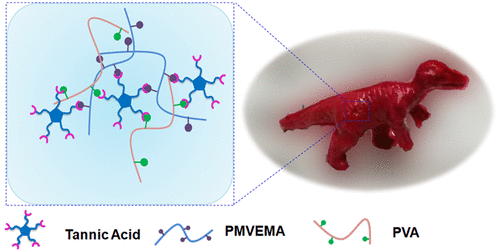当前位置:
X-MOL 学术
›
ACS Appl. Polym. Mater.
›
论文详情
Our official English website, www.x-mol.net, welcomes your
feedback! (Note: you will need to create a separate account there.)
Hydrogen-Bonding-Driven Multifunctional Polymer Hydrogel Networks Based on Tannic Acid
ACS Applied Polymer Materials ( IF 4.4 ) Pub Date : 2022-02-04 , DOI: 10.1021/acsapm.1c01724 Yongfeng Gao 1, 2 , Xuwen Peng 2 , Qiuqiu Wu 1 , Diling Yang 2 , Wenda Wang 2 , Qiongyao Peng 2 , Tao Wang 2 , Jianmei Wang 3 , Jifang Liu 1 , Hao Zhang 2 , Hongbo Zeng 2
ACS Applied Polymer Materials ( IF 4.4 ) Pub Date : 2022-02-04 , DOI: 10.1021/acsapm.1c01724 Yongfeng Gao 1, 2 , Xuwen Peng 2 , Qiuqiu Wu 1 , Diling Yang 2 , Wenda Wang 2 , Qiongyao Peng 2 , Tao Wang 2 , Jianmei Wang 3 , Jifang Liu 1 , Hao Zhang 2 , Hongbo Zeng 2
Affiliation

|
A hydrogel network based on noncovalent intermolecular interactions via mixing of poly(methyl vinyl ether-alt-maleic anhydride) (PMVEMA), poly(vinyl alcohol) (PVA), and tannic acid (TA) aqueous solutions was developed. The coacervation and hydrogel formation process is driven by hydrogen-bonding interactions between catechol moieties of TA, hydroxide groups of PVA, and carboxylic acid groups of PMVEMA. The formation of the PMVEMA–PVA–TA (PPTA) gel occurs in seconds and can be readily obtained and scaled up in both ionic and nonionic systems. It is noteworthy that this PPTA gel can be stretched more than 135 times its original size and for potential preparation of mechanically strong fibers. The gel can be also remodeled on diverse substrates and into different shapes. The electrical response sensing behavior promotes the PPTA gel material as a great candidate for fabricating strain sensors. The as-prepared PPTA gel exhibits excellent adhesion to different substrates and shows antibacterial properties against both Escherichia coli (Gram-negative) bacteria and methicillin-resistant Staphylococcus aureus (MRSA) bacteria, which provides a promising candidate for the design of biocompatible drug carriers with facile fabrication and flexible modification for various biomedical applications.
中文翻译:

基于单宁酸的氢键驱动多功能聚合物水凝胶网络
基于非共价分子间相互作用的水凝胶网络,通过混合聚(甲基乙烯基醚-alt )-马来酸酐)(PMVEMA)、聚(乙烯醇)(PVA)和单宁酸(TA)水溶液被开发出来。凝聚和水凝胶形成过程是由 TA 的儿茶酚部分、PVA 的羟基和 PMVEMA 的羧酸基团之间的氢键相互作用驱动的。PMVEMA-PVA-TA (PPTA) 凝胶的形成在几秒钟内发生,并且可以在离子和非离子系统中轻松获得和放大。值得注意的是,这种 PPTA 凝胶可以拉伸到其原始尺寸的 135 倍以上,并有可能制备机械强度高的纤维。凝胶也可以在不同的基材上重新塑造成不同的形状。电响应传感行为促使 PPTA 凝胶材料成为制造应变传感器的理想材料。大肠杆菌(革兰氏阴性)细菌和耐甲氧西林金黄色葡萄球菌(MRSA)细菌,为生物相容性药物载体的设计提供了一个有希望的候选者,这些药物载体具有易于制造和灵活修饰的各种生物医学应用。
更新日期:2022-02-04
中文翻译:

基于单宁酸的氢键驱动多功能聚合物水凝胶网络
基于非共价分子间相互作用的水凝胶网络,通过混合聚(甲基乙烯基醚-alt )-马来酸酐)(PMVEMA)、聚(乙烯醇)(PVA)和单宁酸(TA)水溶液被开发出来。凝聚和水凝胶形成过程是由 TA 的儿茶酚部分、PVA 的羟基和 PMVEMA 的羧酸基团之间的氢键相互作用驱动的。PMVEMA-PVA-TA (PPTA) 凝胶的形成在几秒钟内发生,并且可以在离子和非离子系统中轻松获得和放大。值得注意的是,这种 PPTA 凝胶可以拉伸到其原始尺寸的 135 倍以上,并有可能制备机械强度高的纤维。凝胶也可以在不同的基材上重新塑造成不同的形状。电响应传感行为促使 PPTA 凝胶材料成为制造应变传感器的理想材料。大肠杆菌(革兰氏阴性)细菌和耐甲氧西林金黄色葡萄球菌(MRSA)细菌,为生物相容性药物载体的设计提供了一个有希望的候选者,这些药物载体具有易于制造和灵活修饰的各种生物医学应用。


















































 京公网安备 11010802027423号
京公网安备 11010802027423号